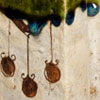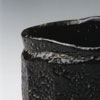In the twelfth century, Zen monks traveling from China introduced to the Japanese the custom of drinking powdered green tea whisked with hot water. Japan's powerful warlords soon began serving the exotic beverage at social gatherings, where they flaunted their burgeoning wealth. Within impressive halls furnished with gilded and painted screens, servants prepared the tea, using rare, imported ceramics. Connoisseurs employed by the military commanders to care for their valuable art collections were responsible for the evolution of a new aesthetic in the sixteenth century. Wabicha, or "rustic tea," involved serving tea in unadorned, intimate settings. Sen no Rikyū (1521-91), Japan's greatest tea master, also advocated using simply formed and fired ceramics that were made in Japan, in addition to rare treasures from the continent. While Rikyū initially used "found" utilitarian vessels, potters soon were making wares based on his specifications. Korean potters forced to emigrate to Japan by the warlord Toyotomi Hideyoshi in the late sixteenth century brought with them advanced kiln technology and Korean pottery styles, further stimulating the development of a thriving ceramics industry. Inspired by tea masters and supported by their wealthy patrons, potters created an astonishing array of new ceramic designs-from unglazed wares that showcased the natural texture and color of the clay to thickly glazed pieces with tactile appeal.
EXHIBITION PREVIEW: The Artistry of Artlessness
Arts of the Tea Ceremony





















